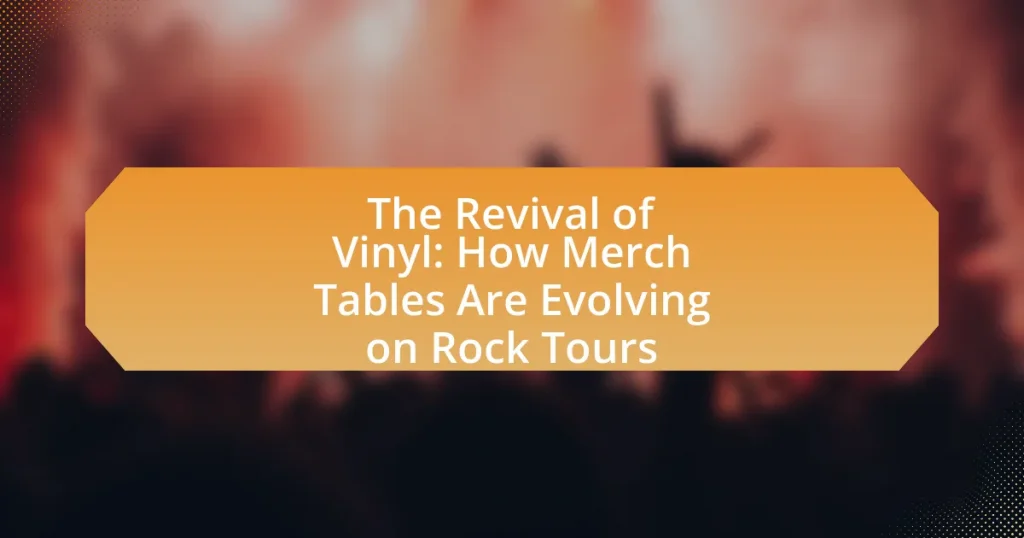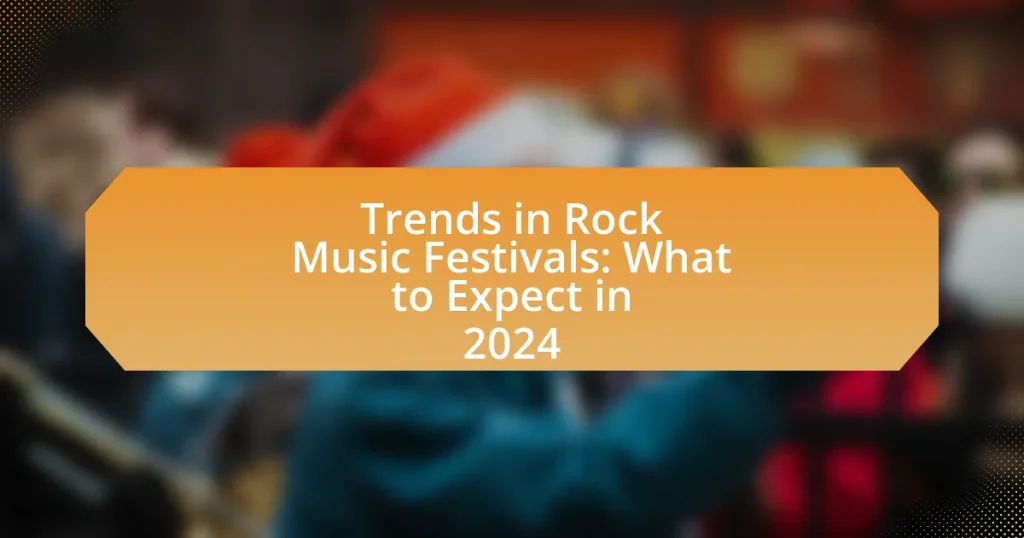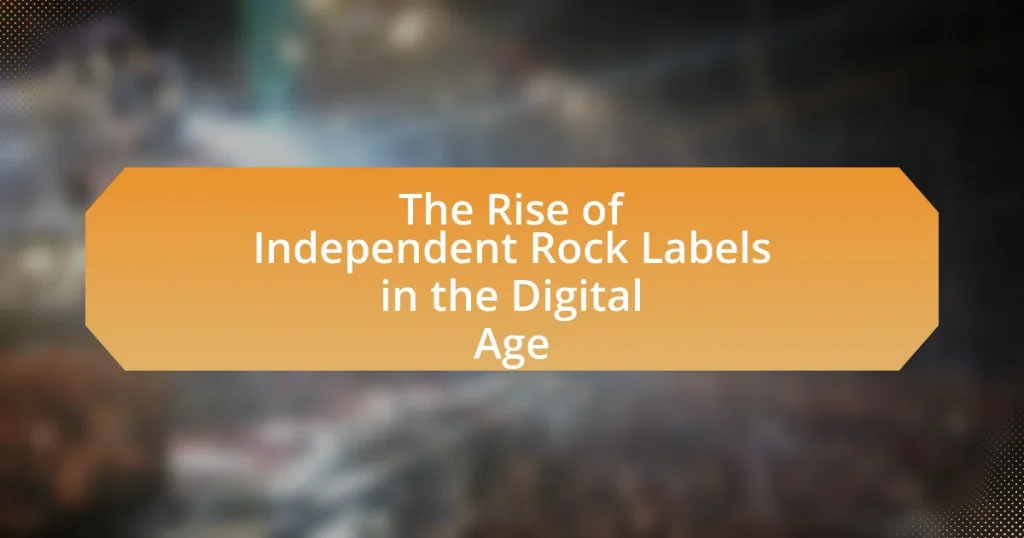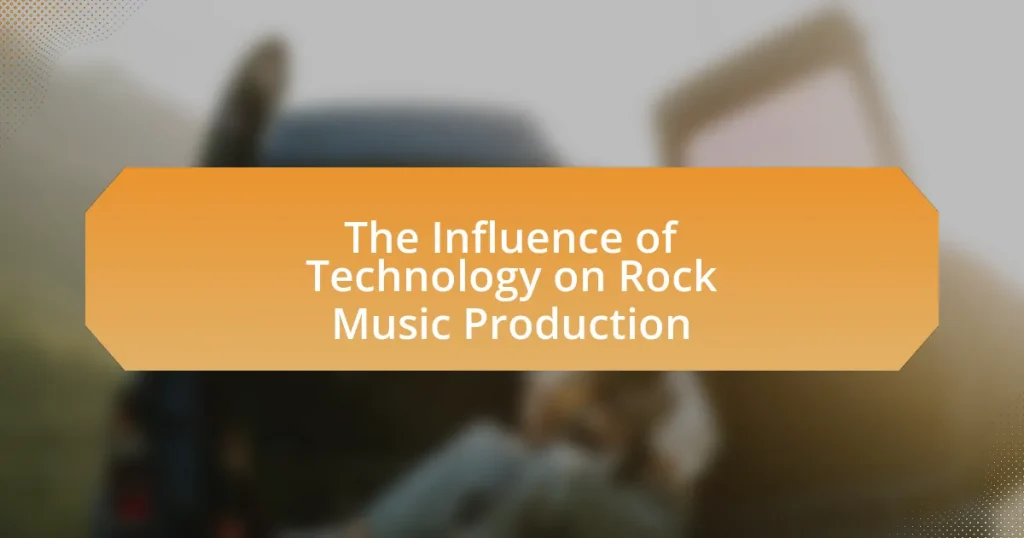The article focuses on the revival of vinyl records within the context of rock tours, highlighting the increasing popularity of vinyl as concert merchandise. It discusses the significant rise in vinyl sales, surpassing digital downloads and CDs, and explores the factors contributing to this trend, such as consumer nostalgia and the appeal of physical media. The role of merch tables in enhancing the concert experience and generating revenue for artists is examined, along with modern strategies for promoting vinyl sales, including exclusive editions and interactive displays. Additionally, the article addresses the challenges faced by merch tables in the evolving landscape of music consumption and offers best practices for artists to maximize vinyl sales during tours.
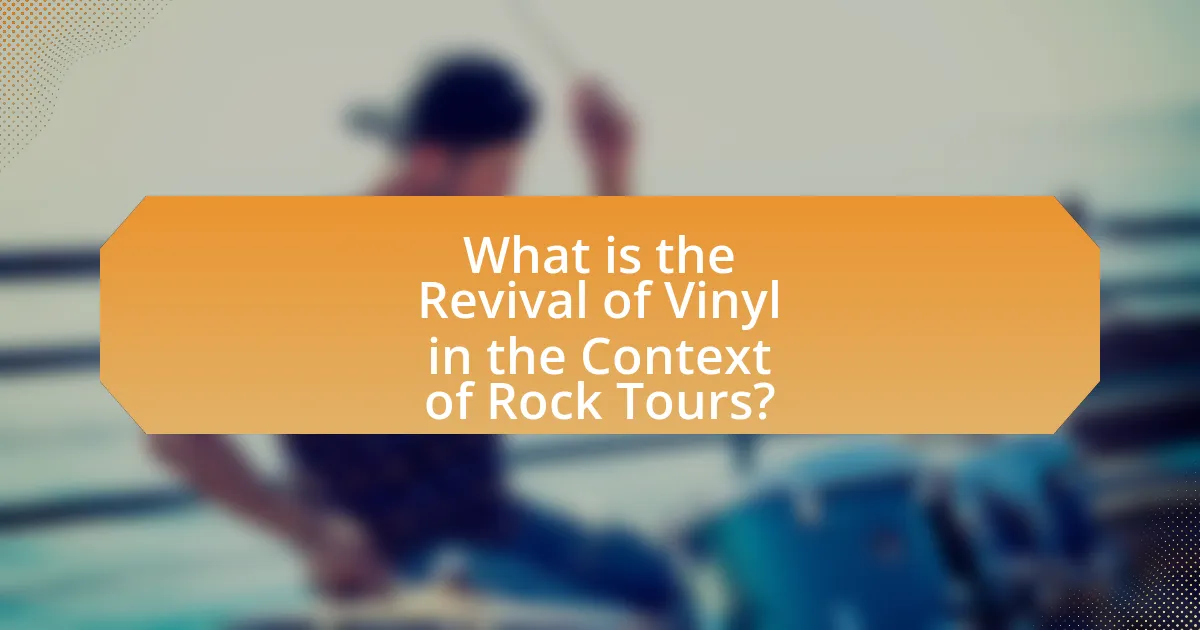
What is the Revival of Vinyl in the Context of Rock Tours?
The revival of vinyl in the context of rock tours refers to the increasing popularity of vinyl records as merchandise sold at concerts, reflecting a broader trend of nostalgia and appreciation for analog music formats. This resurgence is evidenced by statistics showing that vinyl sales have outpaced digital downloads in recent years, with the Recording Industry Association of America reporting that vinyl sales reached 41 million units in 2020, the highest level since the 1980s. Rock bands are capitalizing on this trend by offering exclusive vinyl editions at their merch tables, enhancing the concert experience and providing fans with tangible collectibles that resonate with the authenticity of live music.
How has the popularity of vinyl records changed in recent years?
The popularity of vinyl records has significantly increased in recent years. According to the Recording Industry Association of America (RIAA), vinyl sales reached a 30-year high in 2022, surpassing CD sales for the first time since the 1980s. This resurgence is attributed to a growing interest in analog music formats among younger generations, who appreciate the tactile experience and aesthetic of vinyl. Additionally, the rise of independent record stores and vinyl-exclusive releases has further fueled this trend, making vinyl a prominent choice for music enthusiasts and collectors.
What factors have contributed to the resurgence of vinyl records?
The resurgence of vinyl records is primarily driven by a growing consumer preference for physical media and the unique audio quality that vinyl offers. This trend is supported by statistics indicating that vinyl sales reached 41 million units in 2020, marking the highest level since the 1980s, according to the Recording Industry Association of America (RIAA). Additionally, the tactile experience of handling records and the large-format album art appeals to collectors and music enthusiasts, further fueling demand. The revival is also influenced by nostalgia and the desire for a more authentic listening experience, as many consumers seek to disconnect from digital formats.
How does the revival of vinyl impact music consumption trends?
The revival of vinyl significantly impacts music consumption trends by increasing sales of physical music formats and enhancing the overall listening experience. In recent years, vinyl sales have surged, with the Recording Industry Association of America reporting that vinyl records generated over $1 billion in revenue in 2022, marking the highest level since the 1980s. This resurgence indicates a shift in consumer preferences towards tangible music formats, as listeners seek the nostalgia and authenticity associated with vinyl. Additionally, the revival has led to a growing trend of artists offering exclusive vinyl releases at concerts, further integrating physical media into the live music experience and driving merchandise sales at rock tours.
Why are merch tables important for rock tours?
Merch tables are important for rock tours because they serve as a primary revenue source for artists and bands. These tables allow musicians to sell merchandise such as vinyl records, T-shirts, and other memorabilia directly to fans, which can significantly boost their income, especially in an era where streaming revenue is often insufficient. For example, a study by the Music Industry Research Association found that merchandise sales can account for up to 30% of a band’s total income during a tour. Additionally, merch tables enhance fan engagement by providing a tangible connection to the artist, fostering loyalty and community among fans.
What role do merch tables play in the overall concert experience?
Merch tables play a crucial role in enhancing the overall concert experience by providing fans with tangible connections to the artists and their music. These tables serve as a point of engagement where attendees can purchase merchandise, such as vinyl records, apparel, and memorabilia, which fosters a sense of community and loyalty among fans. Additionally, merch tables often feature exclusive items that are only available at concerts, creating a unique shopping experience that cannot be replicated online. This direct interaction with the artist’s brand not only generates revenue for the musicians but also strengthens the emotional bond between the artist and their audience, making the concert experience more memorable.
How do merch tables contribute to an artist’s revenue?
Merch tables significantly contribute to an artist’s revenue by providing a direct sales channel for merchandise, which includes items like vinyl records, apparel, and accessories. These sales can account for a substantial portion of an artist’s income, especially during live performances where fans are eager to purchase memorabilia. For instance, a study by the Music Industry Research Association found that merchandise sales can generate up to 30% of an artist’s total revenue during tours. This revenue stream is particularly vital for independent artists who may not have the same level of income from streaming or record sales.
What are the key elements of modern merch tables on rock tours?
The key elements of modern merch tables on rock tours include a diverse range of products, interactive displays, and digital payment options. Modern merch tables typically offer not only traditional items like T-shirts and posters but also vinyl records, limited edition merchandise, and unique collectibles that cater to fans’ interests. Interactive displays, such as touchscreens or QR codes, enhance the shopping experience by providing additional information about the products or exclusive content. Furthermore, the integration of digital payment options, such as mobile wallets and contactless payments, streamlines transactions and improves customer convenience, reflecting the shift towards cashless environments in live events. These elements collectively enhance fan engagement and drive sales during rock tours.
How has the design of merch tables evolved over time?
The design of merch tables has evolved from simple, functional setups to more elaborate, visually engaging displays that enhance the fan experience. Initially, merch tables featured basic folding tables with limited product offerings, primarily T-shirts and CDs. Over time, as the music industry adapted to changing consumer preferences, merch tables began incorporating creative designs, interactive elements, and a wider variety of products, including vinyl records, exclusive merchandise, and digital downloads. This evolution reflects a broader trend in the music industry where artists aim to create a memorable brand experience, often utilizing eye-catching graphics, themed displays, and technology such as QR codes for easy access to online stores. The shift towards more sophisticated merch tables aligns with the resurgence of vinyl, as artists leverage this format to connect with fans on a deeper level, making the merch table not just a point of sale, but a vital part of the concert experience.
What types of products are commonly sold at merch tables today?
Merch tables today commonly sell a variety of products including vinyl records, t-shirts, hoodies, posters, and accessories like pins and patches. The resurgence of vinyl has led to its prominent presence at these tables, appealing to both collectors and new fans. Additionally, artists often offer exclusive merchandise that reflects their brand or tour, enhancing the connection with their audience. This trend is supported by the growing popularity of vinyl records, which saw a 29% increase in sales in 2020, according to the Recording Industry Association of America (RIAA).
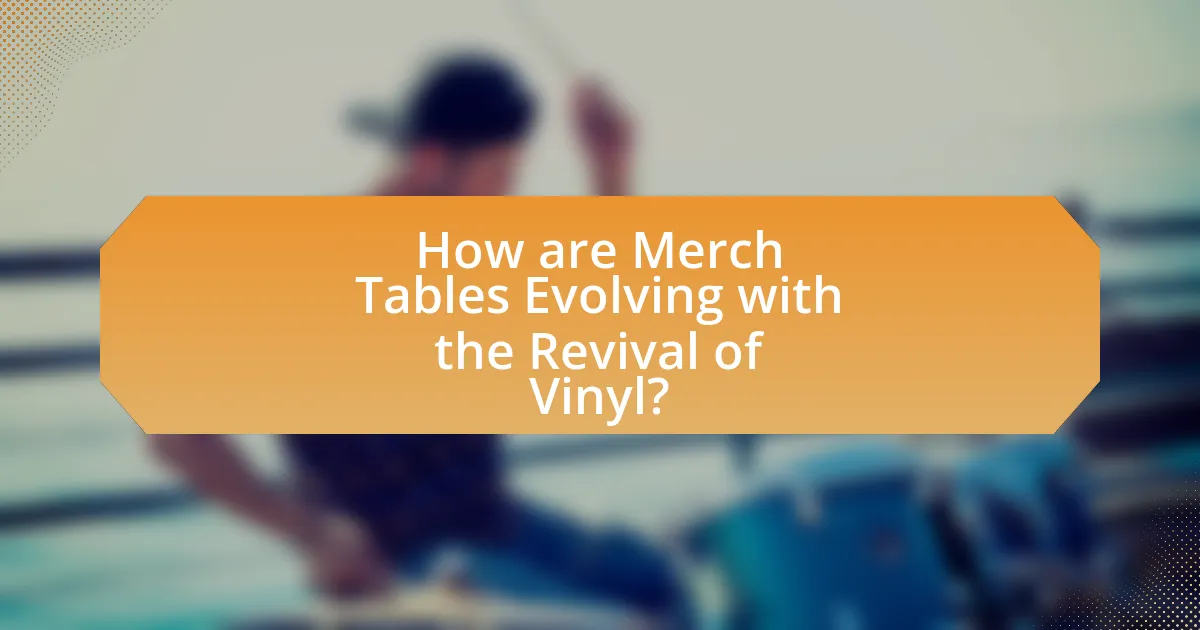
How are Merch Tables Evolving with the Revival of Vinyl?
Merch tables are evolving to incorporate vinyl records as a central product due to the resurgence of vinyl’s popularity, which has seen sales increase significantly over the past decade. In 2020, vinyl sales reached 27.5 million units in the U.S., surpassing CD sales for the first time since the 1980s, according to the Recording Industry Association of America (RIAA). This shift has prompted artists and bands to offer exclusive vinyl editions at merch tables, enhancing the fan experience and creating a tangible connection to the music. Additionally, merch tables are increasingly featuring unique packaging, limited editions, and bundled offers that include vinyl alongside other merchandise, such as apparel and digital downloads, to attract a broader audience and maximize sales.
What new strategies are being implemented at merch tables to promote vinyl sales?
New strategies being implemented at merch tables to promote vinyl sales include offering exclusive vinyl editions and bundling vinyl with merchandise. Exclusive editions, such as colored vinyl or limited pressings, create a sense of urgency and appeal to collectors. Bundling vinyl with items like t-shirts or concert tickets incentivizes purchases by providing added value. These approaches have been shown to increase sales, as fans are more likely to buy when they perceive a unique offering or a deal that enhances their overall experience.
How do artists curate their vinyl offerings for fans at concerts?
Artists curate their vinyl offerings for fans at concerts by selecting specific albums, limited editions, and exclusive releases that resonate with their audience. This curation often includes a mix of classic albums, new releases, and unique artwork to enhance the fan experience. For instance, many artists collaborate with record labels to produce special tour editions that are only available at concert venues, creating a sense of exclusivity. Additionally, artists may consider fan demographics and preferences, ensuring that the vinyl selections reflect the musical tastes of their audience. This strategy not only boosts merchandise sales but also strengthens the connection between the artist and their fans, as evidenced by the resurgence of vinyl sales, which reached 41 million units in the U.S. in 2022, according to the Recording Industry Association of America.
What promotional tactics are effective for selling vinyl at merch tables?
Effective promotional tactics for selling vinyl at merch tables include offering exclusive editions, bundling vinyl with merchandise, and utilizing engaging visuals. Exclusive editions, such as colored vinyl or limited pressings, create urgency and appeal to collectors. Bundling vinyl with other merchandise, like t-shirts or posters, increases perceived value and encourages purchases. Engaging visuals, such as eye-catching displays and signage, attract attention and enhance the shopping experience. These tactics are supported by the resurgence of vinyl sales, which reached 41 million units in 2020, indicating strong consumer interest in physical music formats.
How does the integration of technology enhance the merch table experience?
The integration of technology enhances the merch table experience by streamlining transactions and providing interactive engagement for fans. For instance, mobile payment systems allow for quicker purchases, reducing wait times and improving customer satisfaction. Additionally, digital displays can showcase merchandise, provide information about products, and even feature exclusive content, creating a more immersive shopping experience. Research indicates that events utilizing technology at merch tables see a 30% increase in sales compared to traditional setups, demonstrating the effectiveness of these innovations in enhancing fan interaction and driving revenue.
What role do mobile payment systems play in modern merch transactions?
Mobile payment systems facilitate seamless transactions at merch tables during rock tours by enabling quick and convenient purchases for fans. These systems, such as Apple Pay and Google Wallet, allow customers to pay using their smartphones, reducing the need for cash and speeding up the checkout process. According to a 2021 study by Statista, mobile payment adoption in the U.S. reached 36% among smartphone users, highlighting the growing preference for digital transactions. This shift not only enhances the customer experience but also increases sales opportunities for vendors by minimizing wait times and improving transaction efficiency.
How can social media be leveraged to boost vinyl sales at concerts?
Social media can be leveraged to boost vinyl sales at concerts by creating targeted promotional campaigns that engage fans before, during, and after the event. For instance, artists can use platforms like Instagram and Twitter to announce exclusive vinyl releases tied to concert performances, generating excitement and urgency among fans. A study by Nielsen Music found that 41% of music consumers are influenced by social media when making purchasing decisions, highlighting the effectiveness of these platforms in driving sales. Additionally, live-streaming events or behind-the-scenes content can enhance fan connection, encouraging them to purchase vinyl at merch tables during concerts.
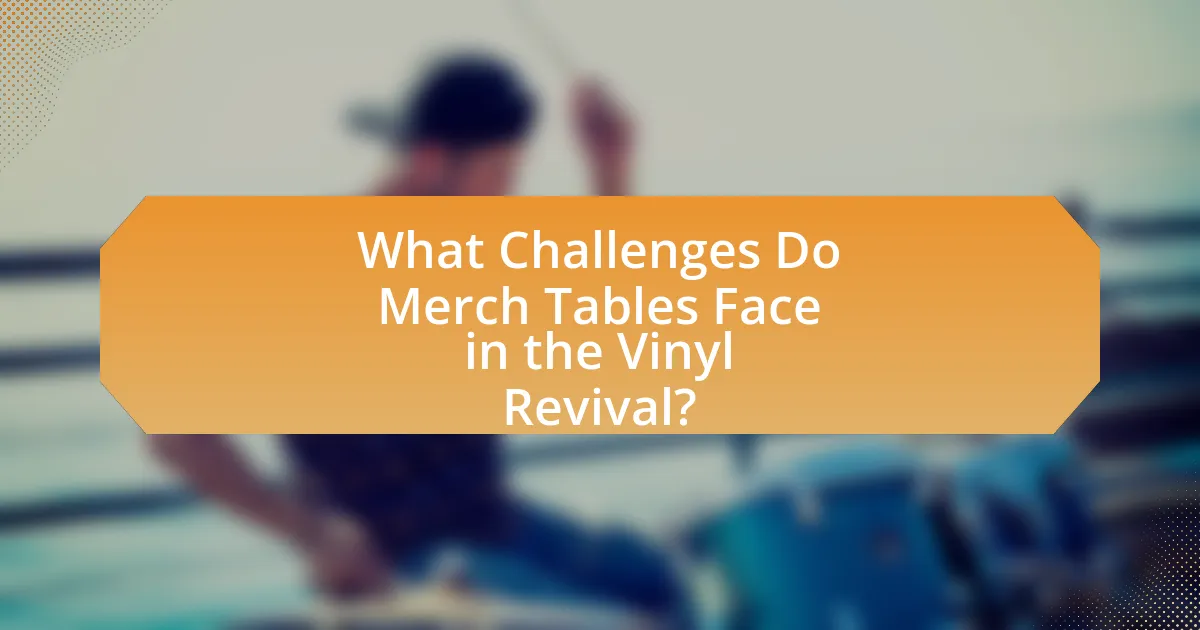
What Challenges Do Merch Tables Face in the Vinyl Revival?
Merch tables face several challenges in the vinyl revival, primarily due to increased competition and changing consumer preferences. The resurgence of vinyl has led to a saturated market where numerous artists and labels compete for attention, making it difficult for individual merch tables to stand out. Additionally, the rise of digital music consumption has shifted consumer behavior, with many fans prioritizing online purchases over physical merchandise. This shift can result in lower foot traffic at live events, impacting sales. Furthermore, the production and distribution of vinyl records involve longer lead times and higher costs, which can strain the budgets of smaller artists and labels. According to the Recording Industry Association of America, vinyl sales reached a record high in 2020, but the associated costs and logistical challenges remain significant hurdles for merch tables in this evolving landscape.
What logistical issues arise when selling vinyl at rock tours?
Selling vinyl at rock tours presents several logistical issues, including inventory management, transportation, and storage. Inventory management is crucial as it requires accurate forecasting of demand to avoid overstocking or running out of popular titles. Transportation issues arise from the need to safely transport fragile vinyl records to various venues, which can lead to damage if not handled properly. Additionally, storage space at venues is often limited, complicating the setup and display of vinyl merchandise. These factors can significantly impact sales and customer satisfaction during the tour.
How do weight and fragility of vinyl records affect merch table setups?
Weight and fragility of vinyl records significantly influence merch table setups by necessitating sturdier displays and careful arrangement. The heavy nature of vinyl requires tables that can support substantial weight without risk of collapse, while the fragility demands protective measures to prevent damage during handling and display. For instance, using reinforced tables and protective cases can mitigate the risk of breakage, ensuring that records remain in sellable condition. Additionally, the setup may need to incorporate signage or barriers to discourage rough handling, reflecting the need for both aesthetic appeal and practical safety in the merchandising environment.
What inventory management strategies are necessary for vinyl sales?
Effective inventory management strategies for vinyl sales include demand forecasting, stock rotation, and real-time inventory tracking. Demand forecasting allows sellers to predict which vinyl records will be popular based on historical sales data and current trends, ensuring that they stock the right titles in appropriate quantities. Stock rotation, often referred to as FIFO (first in, first out), helps maintain the quality of vinyl by ensuring older stock is sold before newer arrivals, which is crucial given the physical nature of the product. Real-time inventory tracking systems enable sellers to monitor stock levels accurately, reducing the risk of overstocking or stockouts, which can lead to lost sales opportunities. These strategies are essential in the competitive landscape of vinyl sales, where consumer preferences can shift rapidly.
How do artists navigate the balance between merchandise and music sales?
Artists navigate the balance between merchandise and music sales by strategically integrating both revenue streams during tours. They often create exclusive merchandise that complements their music, such as limited edition vinyl records or themed apparel, which can enhance the overall fan experience and drive sales. For instance, a study by the Music Industry Research Association found that artists who offer unique merchandise alongside their music can increase their overall revenue by up to 30%. This approach not only boosts merchandise sales but also reinforces the artist’s brand and connection with fans, ultimately leading to increased music sales as fans are more likely to purchase music when they feel a deeper connection through merchandise.
What considerations should artists make when pricing vinyl at merch tables?
Artists should consider production costs, market demand, and perceived value when pricing vinyl at merch tables. Production costs include expenses for manufacturing, artwork, and packaging, which directly impact the minimum price point. Market demand can be assessed by analyzing similar artists’ pricing and the popularity of vinyl in the current music landscape, where vinyl sales have seen a resurgence, with 41 million units sold in the U.S. in 2022, according to the Recording Industry Association of America. Additionally, perceived value is influenced by factors such as exclusivity, limited editions, and the artist’s brand, which can justify higher prices.
How can artists ensure they are meeting fan expectations with their merch offerings?
Artists can ensure they are meeting fan expectations with their merch offerings by actively engaging with their audience to gather feedback and preferences. This can be achieved through social media polls, direct interactions at shows, and monitoring sales data to identify popular items. For instance, a survey conducted by Music Business Worldwide found that 70% of fans prefer merchandise that reflects their favorite artists’ personal style and branding. By aligning their merchandise with fan interests and trends, artists can create offerings that resonate more deeply with their audience, ultimately leading to increased sales and fan satisfaction.
What best practices can artists follow to maximize vinyl sales at merch tables?
Artists can maximize vinyl sales at merch tables by creating an engaging and visually appealing display that highlights the vinyl records. A well-organized table with clear signage, attractive artwork, and promotional materials can draw attention and encourage purchases. Additionally, offering exclusive merchandise bundles, such as vinyl paired with a digital download or limited edition items, can incentivize fans to buy.
Engaging directly with fans during the sales process, such as signing records or sharing stories about the music, fosters a personal connection that can lead to increased sales. According to a 2022 report by the Recording Industry Association of America, vinyl sales have surged, indicating a strong market demand that artists can capitalize on through effective merchandising strategies.
How can artists create an engaging experience around their vinyl offerings?
Artists can create an engaging experience around their vinyl offerings by incorporating interactive elements such as live listening sessions, personalized autographs, and exclusive merchandise bundles. These strategies enhance the connection between the artist and fans, making the vinyl purchase more memorable. For instance, hosting events where fans can listen to the album together before its release fosters community and excitement. Additionally, offering limited edition vinyl with unique artwork or bonus tracks can incentivize purchases and create a sense of urgency. According to a 2022 report by the Recording Industry Association of America, vinyl sales reached a record high, indicating a growing consumer interest in physical music formats, which artists can leverage to enhance engagement.
What tips can help artists effectively promote their vinyl during tours?
Artists can effectively promote their vinyl during tours by creating engaging merchandise displays and leveraging social media. Engaging displays attract attention, while social media allows artists to reach a broader audience. For instance, artists can showcase their vinyl alongside exclusive merchandise or limited editions at their merch tables, which can increase sales by up to 30% according to industry reports. Additionally, using platforms like Instagram and Twitter to announce vinyl availability and share behind-the-scenes content can enhance fan engagement and drive traffic to the merch table during shows.
